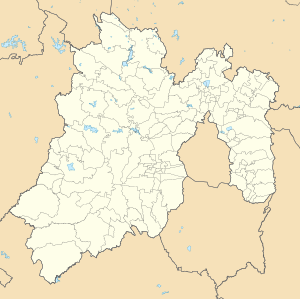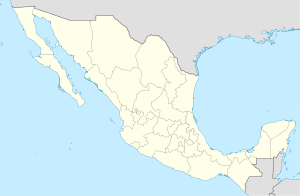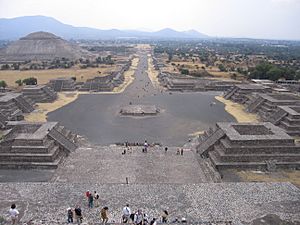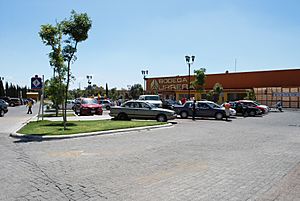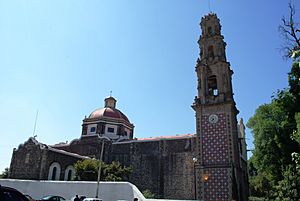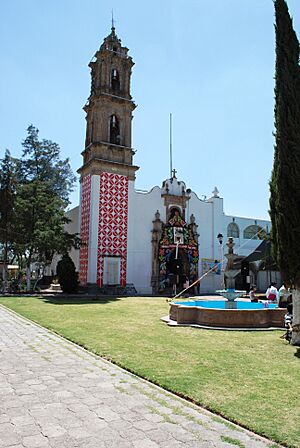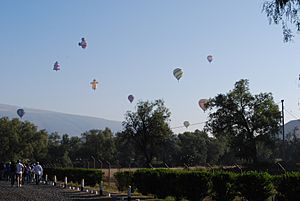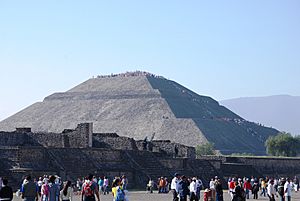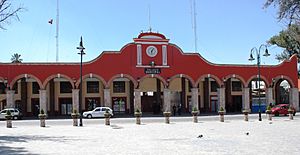Teotihuacán Municipality facts for kids
Quick facts for kids
Teotihuacán
Teotihuacán
|
|
|---|---|
|
Municipality
|
|
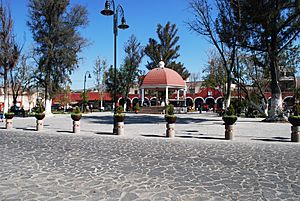
Main plaza of the town
|
|
| Country | |
| State | State of Mexico |
| Municipal Seat | Teotihuacán de Arista |
| Founded | 500 B.C.E. |
| Municipality Founded | 1882 |
| Elevation
(of seat)
|
2,270 m (7,450 ft) |
| Population
(2005) Municipality
|
|
| • Municipality | 46,779 |
| • Seat | 21,577 |
| Time zone | UTC-6 (Central (US Central)) |
| • Summer (DST) | UTC-5 (Central) |
| Postal code (of seat) |
55880
|
Teotihuacán is a municipality in the State of Mexico. The main town is Teotihuacán de Arista. It is located northeast of the Valley of Mexico, about 45 kilometers (28 miles) from Mexico City. The name "Teotihuacan" comes from the Nahuatl language. It means "place of the gods." Ancient myths say the Sun and Moon were created here.
The municipality's symbol shows the Pyramid of the Sun. This pyramid represents the four main directions. It is also linked to a figure that stands for water. This figure connects to an arm, which joins the head of a seated person speaking. This person represents a god. The area's history is closely tied to the famous ancient city of Teotihuacan.
Contents
Discovering Teotihuacán's Past
According to old myths, gods chose this place to create the center of the universe. People first settled here around 500 BCE. They started as a village making things from stone. By the 2nd century CE, it grew into a major political and religious city. This important city lasted until the 9th century. It was the largest city in central Mexico until Tenochtitlan was built much later.
Today, only the ancient city's ruins remain. These ruins include amazing structures like the Pyramids of the Sun and Moon. You can also see the Temple of Quetzalcoatl and a large market area. Many smaller buildings were government offices.
Teotihuacán After the Conquest
When the Spanish arrived, the Aztecs respected the Teotihuacan area greatly. But this changed with the arrival of Christianity. The area then came under the control of Texcoco. By the late 1500s, it was renamed San Juan Teotihuacan.
During the Mexican War of Independence, no battles happened here. However, both sides of the war passed through the area. The municipality had to provide a lot of food for Mexico City. This caused many farms to be abandoned.
The Mexican Revolution in the early 1900s also greatly affected the area. Different groups of fighters came and went. This led to chaos and a shortage of food. By the end of the war, many fields were ruined, and people faced widespread hunger.
Exploring the Ancient City
Since the Revolution, the municipality's history has been linked to the archeological site. Archeologists began exploring the site in 1905. The Pyramid of the Sun was the first to be studied and rebuilt. Other religious buildings were explored later.
In the 1960s, the Instituto Nacional de Antropología e Historia (INAH) continued the work. They explored and restored many important areas. These included the Palace complex Quetza-Mariposa and the Avenue of the Dead. They also worked on the Pyramid of the Moon and finished the Pyramid of the Sun. A new highway from Mexico City was also built. The site opened to the public in 1964.
Protecting the Site
The archeological site brings money to the municipality. But it has also caused some disagreements. INAH has divided the area into three zones: A, B, and C. Zone A includes the main pyramids and structures. Zones B and C are areas around Zone A. Each zone has rules about building and land use. These rules depend on how close an area is to the center of the site. Sometimes, these rules clash with plans for new buildings.
One big disagreement happened in the mid-2000s. A company called Bodega Aurrerá, part of Wal-Mart of Mexico, wanted to build a supermarket. This supermarket was planned for the Purificación neighborhood, which is in Zone C. Local officials and INAH gave permission, but with some rules. However, many people, including famous artists and writers, were against the store. They worried about its effect on culture and local businesses. Despite the concerns, the store was built and opened in 2005.
In 2008, the Vatican approved a new church area for San Juan Teotihuacan. The first bishop was from the Teotihuacan area. In 2015, Teotihuacán joined the "Pueblos Mágicos" program. This program recognizes towns for their special charm and history.
Exploring the Town of Teotihuacán
The town of Teotihuacán has been named a "Pueblo con Encanto" (Town with Charm). This is because of its rich history and the ancient archeological site nearby. It also has many old buildings.
Historic Buildings and Markets
The modern town began with the former monastery of San Juan Evangelista. It was built in 1548. The entrance to the church has decorated arches. The front of the church has carved stone and statues of saints. The bell tower has an old bell and cactus-shaped decorations. Next to the main church is an open chapel. It has six arches and a baptismal font. Inside the church, you can see a beautifully carved wooden pulpit. Much of the old monastery area is still there.
Mondays are market days in Teotihuacán. The town hosts one of the most traditional "tianguis" (open-air markets) in the Valley of Mexico. Hundreds of stalls are set up between the archeological site and the old monastery. You can find lots of food and prepared dishes. The market is famous for its fresh fruits and vegetables. It also sells many craft items.
At this market and the permanent municipal market, you can try local foods. These include barbacoa (slow-cooked meat), mixiote (meat cooked in a leaf), quail, and dishes made with nopal (cactus pads). The municipal market dates back to the early 1900s. In 2005, when the market was installing a new drainage system, archeologists were called in. They found parts of an ancient home altar from around 450 CE. They also found three graves with the remains of six people.
In the La Concepción neighborhood, you can find the Temple of Nuestra Señora de la Purificacíon. Its main entrance is made of carved stone in the Baroque style. The front of the church has beautiful decorations with flowers and plants. The tower has special columns.
Gardens and Festivals
The Jardin de las Cactáceas, or Cactus Garden, covers four hectares (about 10 acres). It shows many different plants found in Mexico's deserts. You can see maguey, various palms, and different types of barrel cactus. It is located right next to the archeological site.
The town has two main traditional festivals. One is for John the Baptist, the town's patron saint, in late June. The other is the feast of Christ the Redeemer in July. This festival happens at the same time as the Obsidian Fair. During the eight-day Christ the Redeemer festival, you can see traditional dances. There are also rides, fireworks, and sports events.
Two other yearly events have been added since the 2000s. The Festival Aerostatico Teotihuacan (Teotihuacan Hot-Air Balloon Festival) has been held every year since 2005. About 15,000 people come each year to see around twenty balloons. Other activities include paragliding and skydiving shows. There are also farming and livestock displays, and a food and crafts fair. The festival takes place at the "Globopuerto Volare."
The Festival Musica para los Dioses (Music for the Gods Festival) is an annual rock and roll event. It has attracted up to fifty bands and crowds of over 20,000 people. Attendees can camp in a safe area, making it like a small Woodstock. This festival has been happening since 2006. It is considered Mexico's most important rock and camping festival.
The Ancient Teotihuacan Site
The main attraction here is the Teotihuacan archeological site. It is a World Heritage Site. The center of the site is the Calzada de los Muertos, or Avenue of the Dead. This avenue is almost four kilometers (2.5 miles) long. The city was built around this avenue in a very organized way. You can see this best from the Pyramid of the Moon at the north end or the Temple of Quetzalcoatl at the south end.
Most visitors go to the Pyramid of the Sun first, then the Pyramid of the Moon. The Pyramid of the Sun is the second largest in Mexico. It is 64 meters (210 feet) tall and has five levels with stairs. Visitors can climb to the top. Many believe it has special energy, especially during the spring equinox. The Pyramid of the Moon is at the north end of the Avenue of the Dead. It has four levels with stairs.
There are many other palaces and buildings to visit. These include The Citadel, the Palace of Quetzalpapalotl, the Temple of the Plumed Snails, and the Palace of the Jaguars. A new museum at the site shows 34 of the site's murals and other artifacts.
Tourism and Challenges
Even though the site is very important, it hasn't led to a huge tourism industry. There are only a few hotels nearby. Most people who work in tourism sell souvenirs inside and outside the site. Overall, only about 32% of the local population works in tourism and general business.
The area around the entrance can be very busy. There are many stands selling souvenirs and many street vendors. Inside and outside the main site, there are hundreds of vendors and shops. Many of these have been built since the 1980s on what used to be farmland. This farmland was one reason UNESCO made Teotihuacan a World Heritage Site. INAH knows that the many stands are not ideal. They are working with local authorities to move businesses into permanent buildings. However, many vendors do not want to move.
New commercial centers near the site have also caused issues. In the 1990s, a large shopping area was built in Zone B. After many legal battles, the land was taken by the government, and the buildings were torn down in 2003.
In 2004 and 2005, the plan to build the Bodega Aurrera supermarket caused more debate. Even though it was in Zone C, where building is allowed, many people worried about a large store so close to the ancient pyramids. Opponents included people who wanted to protect the environment and local culture. The supermarket was built and opened in November 2004. It is about 2.4 kilometers (1.5 miles) from the Pyramid of the Sun and cannot be seen from its top.
The supermarket has been successful. It brings thousands of shoppers each week and has created jobs. However, its location at the town's entrance has made traffic worse. In 2009, there was another disagreement about plans to light the pyramids at night. Archeologists worried that installing the lights would damage the ancient structures.
The Municipality of Teotihuacán
The town of San Juan Teotihuacán is the main governing center for about 115 other communities. The total area of the municipality is 82.65 square kilometers (31.9 square miles). Less than half of the municipality's population lives in the main town. The municipality shares borders with other municipalities like Temascalapa and San Martín de las Pirámides.
Geography and Climate
Most of the land is flat, but there are some large hills. The most important rivers are the San Juan and the San Lorenzo. Both of these rivers flow through the main town. There are also fresh water springs that provide drinking and irrigation water. The climate is mild and semi-dry, with rain in the summer. The average yearly temperature is about 15.4°C (59.7°F). It can get frosts from October to March.
Some parts of the municipality have small forests with cedar, pine, and fir trees. Other areas have plants that grow in dry climates, like cactus and maguey. Wildlife includes skunks, rabbits, moles, hummingbirds, quail, and rattlesnakes. There are also many other birds, reptiles, and insects.
Economy and Attractions
Most of the land in the municipality is used for farming. Forests cover about 14% of the area. Most farming depends on the yearly rainy season. Main crops include alfalfa, oats, beans, corn, and prickly pears. There are also orchards that grow pears, apples, peaches, and other fruits. Most livestock are pigs or chickens kept by families. Farming employs almost half (48%) of the municipality's people. Many crafts made here are copies of ancient pieces sold to tourists.
There is some industry, mainly processing farm products like food, drinks, and wood. There is also some industry related to oil and other chemicals. This sector employs about 20% of the population.
Outside the town and the ancient site, there are other places to visit. Reino Animal (Animal Kingdom) is a safari park where animals roam freely. Visitors stay in vehicles. There are also two spas or water parks called Cuauhtemoc and La Fuente. These parks have swimming pools, slides, and green areas.
See also
 In Spanish: Municipio de Teotihuacán para niños
In Spanish: Municipio de Teotihuacán para niños


